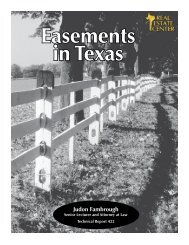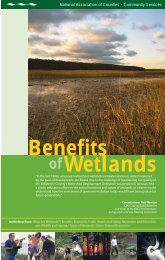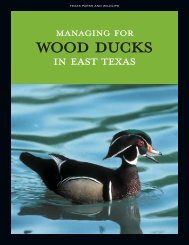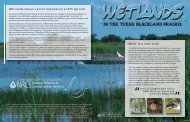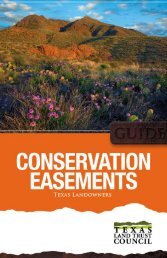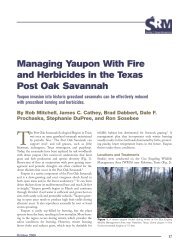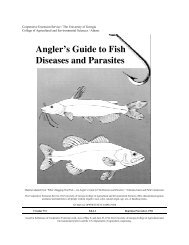Texas Farm Ponds: Stocking, Assessment, and Management ...
Texas Farm Ponds: Stocking, Assessment, and Management ...
Texas Farm Ponds: Stocking, Assessment, and Management ...
You also want an ePaper? Increase the reach of your titles
YUMPU automatically turns print PDFs into web optimized ePapers that Google loves.
designs exist, ranging from surface-release drains to<br />
bottom-siphoning systems. For fishing ponds, the<br />
bottom-release designs are considered more<br />
desirable because poorer quality water near the<br />
bottom is passed through while retaining higher<br />
quality surface water. Design emergency spillways<br />
to allow passage of flood waters (usually around the<br />
end of the dam) with care to avoid soil erosion.<br />
5. Design your pond shoreline slopes. Slopes of at<br />
least 2.5:1 ratio (2.5-feet drop per 1 foot from shore)<br />
are best to avoid large expanses of shallow water.<br />
Shallow water (< 3 feet deep) allows sunlight to<br />
penetrate to bottom sediments, which can encourage<br />
excessive aquatic plant growth. Steeper slopes can<br />
also position fish within easier casting distance of<br />
bank anglers. However, slopes should also depend<br />
on soil type <strong>and</strong> effort should be given to guard<br />
against erosion of steeply sloping banks.<br />
6. The final planning stage should be devoted to<br />
including habitat improvement structures to be<br />
added prior to pond filling. Fish habitat can be added<br />
later, but is much easier before the pond fills with<br />
water. For information concerning pond habitat <strong>and</strong><br />
fish attraction structures, see the Pond Habitat<br />
section <strong>and</strong> the Habitat heading within the<br />
References section.<br />
Pond Size. The size of your pond is the major<br />
factor that will determine what fish to stock, the<br />
degree of management needed to maintain these fish,<br />
<strong>and</strong> how many fish you can harvest each year. Most<br />
farm ponds in <strong>Texas</strong> are built for livestock watering<br />
<strong>and</strong> are less than 1 acre in surface area. Although<br />
owners of small ponds traditionally want “bass in<br />
their tanks,” these small ponds are really not suited<br />
for bass populations. Bass harvest management in<br />
small ponds is especially difficult <strong>and</strong> unrewarding,<br />
as nearly all bass caught must be released to prevent<br />
overpopulation by forage species. In small ponds, it<br />
is usually better to stock only catfish, since they<br />
provide more fishing recreation, food for the table,<br />
<strong>and</strong> can be fed commercially prepared feed. <strong>Ponds</strong><br />
larger than 1 surface acre are more suitable for<br />
multiple species. If these larger ponds are stocked,<br />
managed, <strong>and</strong> harvested properly, you can expect<br />
many years of satisfactory fishing for all sport<br />
species. If you prefer, they also can be managed for<br />
only catfish.<br />
Many pond owners have difficulty estimating the<br />
surface area of their ponds. It is easy to<br />
overestimate, <strong>and</strong> this often leads to overstocking. If<br />
your pond fluctuates considerably in surface area,<br />
stock it based on the average annual low-water<br />
surface area. Remember that 1 surface acre contains<br />
43,560 square feet. Formulas for calculating the<br />
surface area in acres of the most common pond<br />
shapes (square or rectangular, triangular, <strong>and</strong> round)<br />
are provided below to assist you in determining the<br />
size of your pond. All dimensions should be<br />
measured in feet.<br />
Recent advances in global positioning system<br />
(GPS) technology allows pond owners to easily<br />
calculate pond surface acreage with a h<strong>and</strong>-held<br />
GPS unit that contains area-calculation<br />
programming. These units are available<br />
commercially.<br />
Pond Habitat. Pond habitat can be simply<br />
defined as the environments that aquatic organisms<br />
live in <strong>and</strong> around. However, this definition<br />
encompasses a broad list of chemical, biological,<br />
<strong>and</strong> physical categories such as water depth,<br />
temperature, <strong>and</strong> oxygen content; pond-bottom<br />
substrate <strong>and</strong> contours; live floating, submerged, <strong>and</strong><br />
emergent vegetation; dead st<strong>and</strong>ing or fallen timber;<br />
<strong>and</strong> artificial “cover” such as sunken concrete<br />
blocks, rocks, <strong>and</strong> “trees” or “reefs” constructed out<br />
of plastic, PVC pipe, <strong>and</strong> other structures. Learning<br />
the habitat requirements <strong>and</strong> preferences of common<br />
fishes will help pond owners to not only manage the<br />
needs of various life stages of those fishes, but also<br />
provide habitat that improves angler success.<br />
Water depth, temperature, <strong>and</strong> chemistry will<br />
affect decisions about species to stock, water<br />
aeration, <strong>and</strong> placement of artificial structure. For<br />
example, in most southern ponds, warm season<br />
water temperatures are too high <strong>and</strong> oxygen too low<br />
for nonnative rainbow trout, but cold winters in the<br />
panh<strong>and</strong>le decrease stocking success of Florida<br />
strain largemouth bass as compared to the native<br />
northern strain. Introduced hybrid striped bass do<br />
not reproduce, so they do not need spawning habitat,<br />
but they do need deep, open water <strong>and</strong> adequate<br />
forage production in those habitats (unless you plan<br />
on supplemental feeding). During summer months,<br />
especially if winds do not regularly agitate the<br />
water’s surface, ponds can stratify into sharply<br />
5



